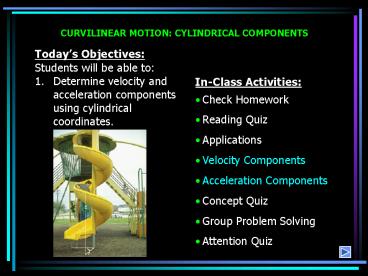Hibbeler Dynamics 12th Edition - PowerPoint PPT Presentation
1 / 14
Title:
Hibbeler Dynamics 12th Edition
Description:
Title: Section 12.8 Subject: Hibbeler Dynamics 12th Edition Author: Alimi & Nam Description: Updated for Pearson 12th Edition Dynamics textbook by Dr. Changho Nam ... – PowerPoint PPT presentation
Number of Views:164
Avg rating:3.0/5.0
Title: Hibbeler Dynamics 12th Edition
1
CURVILINEAR MOTION CYLINDRICAL COMPONENTS
- Todays Objectives
- Students will be able to
- Determine velocity and acceleration components
using cylindrical coordinates.
- In-Class Activities
- Check Homework
- Reading Quiz
- Applications
- Velocity Components
- Acceleration Components
- Concept Quiz
- Group Problem Solving
- Attention Quiz
2
READING QUIZ
3
APPLICATIONS
The cylindrical coordinate system is used in
cases where the particle moves along a 3-D curve.
In the figure shown, the box slides down the
helical ramp. How would you find the boxs
velocity components to know if the package will
fly off the ramp?
4
CYLINDRICAL COMPONENTS (Section 12.8)
We can express the location of P in polar
coordinates as r r ur. Note that the radial
direction, r, extends outward from the fixed
origin, O, and the transverse coordinate, q, is
measured counter-clockwise (CCW) from the
horizontal.
5
VELOCITY in POLAR COORDINATES)
6
ACCELERATION (POLAR COORDINATES)
7
CYLINDRICAL COORDINATES
If the particle P moves along a space curve, its
position can be written as rP rur
zuz Taking time derivatives and using the chain
rule
8
EXAMPLE
9
EXAMPLE (continued)
10
CONCEPT QUIZ
11
GROUP PROBLEM SOLVING
Hint The tangent to the ramp at any point is at
an angle
Plan Use cylindrical coordinates. Since r is
constant, all derivatives of r will be zero.
12
GROUP PROBLEM SOLVING (continued)
13
ATTENTION QUIZ
1. The radial component of velocity of a particle
moving in a circular path is always A) zero. B)
constant. C) greater than its transverse
component. D) less than its transverse
component.
2. The radial component of acceleration of a
particle moving in a circular path is
always A) negative. B) directed toward the
center of the path. C) perpendicular to the
transverse component of acceleration. D) All of
the above.
14
(No Transcript)































